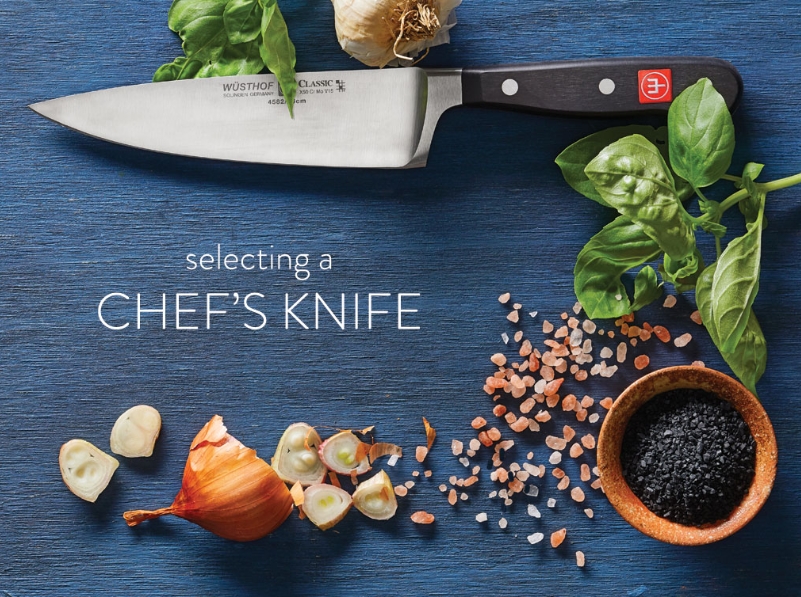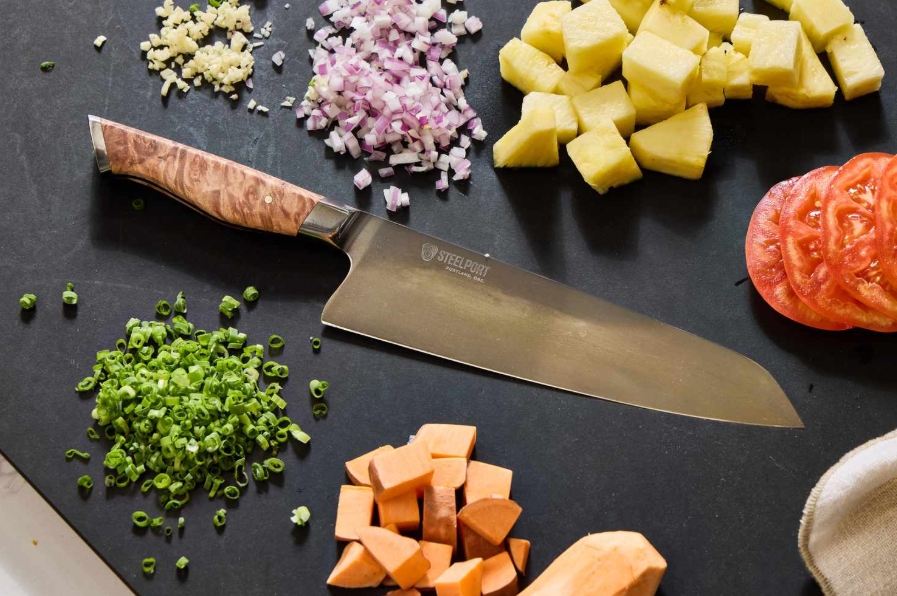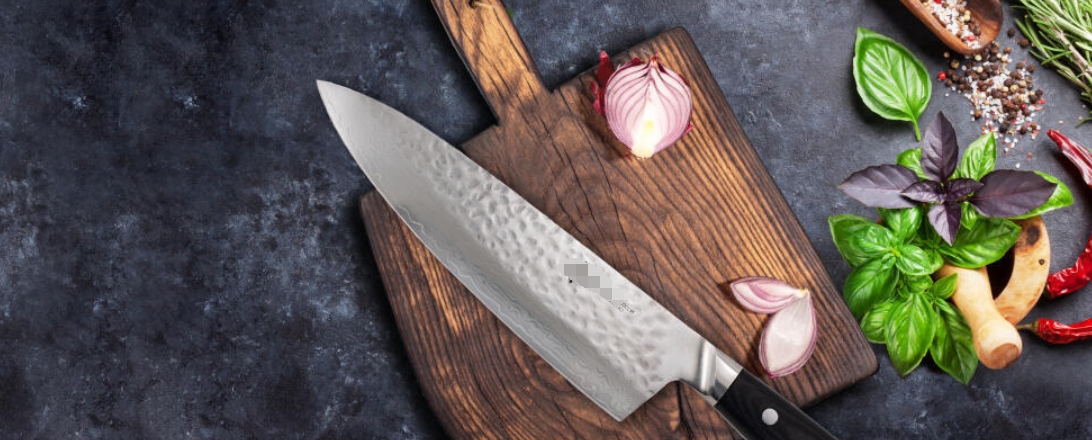

Views: 222 Author: Ella Publish Time: 2025-04-28 Origin: Site








Content Menu
>> German Steel
>> Edge Finish
● Construction and Handle Design
● Frequently Asked Questions (FAQ)
>> 1. What is the main difference between German and Japanese knife steel?
>> 2. Which knife set is better for beginners?
>> 3. Can I use Japanese knives for heavy-duty tasks like cutting bones?
>> 4. How often do I need to sharpen German vs. Japanese knives?
>> 5. Are there hybrid knives combining German and Japanese features?
Choosing the right kitchen knife set is essential for any cooking enthusiast or professional chef. Among the most popular and respected styles are German and Japanese knife sets. Each has unique characteristics influenced by their cultural heritage, manufacturing techniques, and intended culinary uses. This comprehensive article explores the differences between German and Japanese knife sets, covering blade materials, design, sharpness, maintenance, and functionality.

German knives typically use softer stainless steel alloys, such as 1.4116 high-carbon stainless steel, with a Rockwell Hardness rating around 55 to 58 HRC[1][2][15]. This softer steel makes German blades more durable and less prone to chipping or breaking, even when used for heavy-duty tasks like cutting through bones or tough vegetables[7][9][15]. The softer steel also means German knives require more frequent sharpening but are easier to maintain at home[2][7].
Japanese knives are made from harder steel alloys, often with higher carbon content, resulting in Rockwell Hardness ratings between 59 and 65 HRC or even higher for premium blades[1][2][4][5][15]. This hardness allows Japanese knives to hold a sharper edge for longer but makes them more brittle and susceptible to chipping if misused[1][7][15]. Japanese steel is often layered with Damascus patterns for aesthetics and performance[4][12].
- German Knives: Feature thicker, curved blades with a pronounced "belly" that facilitates a rocking motion when chopping. The thickness adds to their robustness and durability[1][6][9][10][16].
- Japanese Knives: Have thinner, straighter blades designed for precise slicing and clean cuts. The straighter edge suits delicate tasks like slicing fish or vegetables[1][6][10][16].
- German Knives: Typically sharpened to a wider edge angle of about 17.5 to 20 degrees per side, resulting in a more durable but less razor-sharp edge[1][2][6][9][15].
- Japanese Knives: Sharpened to a much narrower angle, usually between 12 and 15 degrees per side, allowing for an extremely sharp edge ideal for precision cutting[1][2][6][9][15][18].
Japanese blades are often hand-honed and hand-refined, sometimes featuring hammered or Damascus textures that reduce drag and prevent food from sticking[1][9][13]. German blades are usually machine-finished with smooth surfaces[1][9].
- German Knives: Usually have a full tang, meaning the blade steel extends through the entire handle, providing strength and balance. They tend to be heavier with bolstered handles for a secure grip[1][2][5][6].
- Japanese Knives: Often have a partial or hidden tang, making them lighter and more front-heavy to allow for greater control during precise cuts. Handles are commonly made from wood or composite materials without bolsters[1][2][5][12].
German knives feature ergonomic, symmetrical handles suitable for both right- and left-handed users, designed for comfort during prolonged use[5]. Japanese handles tend to be lighter and more minimalist, prioritizing nimbleness and precision[12].

- German Knives: Known for versatility, German knives excel at chopping, slicing, and cutting a wide range of foods, including tougher meats and vegetables. Their durability makes them ideal for everyday kitchen tasks and heavy-duty use[1][2][5][6].
- Japanese Knives: Designed as precision tools, Japanese knives are perfect for delicate slicing, trimming, and tasks requiring fine control, such as preparing sushi or thin vegetable slices. They are less suited for heavy chopping or cutting through bones[1][2][5][10].
- German Knives: Easier to maintain due to softer steel; they require more frequent sharpening but are less prone to damage. They can often be sharpened with various tools and are generally more forgiving to novice users[2][7][14].
- Japanese Knives: Require careful maintenance due to harder, more brittle steel. Sharpening is best done with whetstones, and honing is essential to maintain the fine edge. They should be handled delicately and not used on hard materials like bones[2][7][14][18].
Both types should never be washed in dishwashers and must be dried promptly to prevent rust and corrosion[2].
- Zwilling Professional “S” Chef's Knife: Forged from a single piece of solid steel with ice-hardened Friodur blade[1].
- Messermeister Meridian Elite Chef's Knife: Made of German 1.4116 high-carbon stainless steel, handcrafted in Solingen[1].
- Wusthof Grand Prix II Cook's Knife: Precision-forged with a pebble-textured handle for comfort[1].
- Nyx Range German Steel Chef Knife Set: Includes 7 pieces made from German 1.4116 high carbon stainless steel with G10 handles, full tang, and V-shaped edges[11].
- Lief + Svein German Steel Knife Block Set: 15-piece set with German 1.4116 steel, hand-polished edges, and ergonomic handles[3].
- Shun Premier Build-A-Block 3-Piece Knife Set: VG-MAX steel core blade with 34 layers of Damascus steel, pakkawood handles, Rockwell hardness 61[4].
- Kanetsune KC-950 DSR-1K6 7-Piece Knife Set: Lightweight, budget-friendly, made with DSR-1K6 steel, laminated wood handles[4].
- Gurenhiryu KAI Series: Handmade knives with SPG STRIX steel, layered Damascus, stabilized wood handles, Rockwell hardness up to 65[12].
- Saji Craft Series: High-end knives with SG2 steel, white turquoise handles, multiple blade types for various tasks[12].
German and Japanese knife sets each offer distinct advantages shaped by their steel composition, blade design, and intended culinary use. German knives provide durability, versatility, and ease of maintenance, making them excellent for heavy-duty kitchen tasks and users who prefer robust tools. Japanese knives excel in precision, sharpness, and control, ideal for delicate slicing and fine culinary work but require more careful handling and maintenance.
Choosing between German and Japanese knife sets depends on your cooking style, preferences for knife weight and sharpness, and willingness to maintain your knives. Hybrid options are increasingly available, blending the best of both worlds for versatile and high-performance kitchen tools.

German knives use softer stainless steel with lower carbon content (55-58 HRC), making them more durable and easier to maintain. Japanese knives use harder steel (59-65 HRC), allowing for sharper edges but making them more brittle and prone to chipping[1][2][15].
German knife sets are generally better for beginners due to their durability, ease of maintenance, and versatility for various kitchen tasks. Japanese knives require more careful handling and specialized sharpening techniques[2][7][14].
No, Japanese knives are designed for precision slicing and are more brittle. Using them on bones or hard materials can cause chipping or damage. German knives are better suited for heavy-duty tasks[1][7][18].
German knives need more frequent sharpening due to softer steel but are easier to sharpen. Japanese knives hold their edge longer but require sharpening with whetstones and more care when sharpening[2][7][14].
Yes, many brands now offer hybrid knives that combine the sharpness and thin blades of Japanese knives with the ergonomic handles and durability of German knives, providing a balance of precision and robustness[5][13].
[1] https://www.gearpatrol.com/home/a336947/german-japanese-kitchen-knife-difference/
[2] https://thegourmetinsider.com/cutlery-101-whats-the-difference-between-german-and-japanese-style-knives/
[3] https://theknifestore.co.uk/products/lief-svein-german-steel-knife-block-set-15-piece-kitchen-knife-sets-german-stainless-1-4116-steel-unique-kitchen-knives-set-with-ipad-holder-ideal-knife-set-with-block-and-sharpener-1
[4] https://www.nothingbutknives.com/best-kitchen-knives-from-japan/
[5] https://prudentreviews.com/japanese-vs-german-kitchen-knives/
[6] https://knifesharpeninglosangeles.com/chef-knife-comparison-german-vs-japanese-knives/
[7] https://www.reddit.com/r/chefknives/comments/pm1fp2/why_german_knives_are_better_than_japanese_knives/
[8] https://www.korin.com/japanese-knife-faq
[9] https://www.cozymeal.com/magazine/japanese-vs-german-knives
[10] https://madeincookware.com/blogs/japanese-vs-german-knives
[11] https://www.edwardskingofsmoke.co.uk/product/nyx-range-german-steel-chef-knife-set/
[12] https://japaneseknifecompany.com
[13] https://www.youtube.com/watch?v=0hjvEXfaR2E
[14] https://santokuknives.co.uk/blogs/blog/what-are-the-pros-and-cons-of-german-knife-sets
[15] https://www.meesterslijpers.nl/en/german-vs-japanese-knives
[16] https://elementknife.com/pages/german-vs-japanese-cutlery
[17] https://www.shanzushop.com/products/german-steel-14-pcs-knife-set
[18] https://oishya.com/journal/whats-difference-german-japanese-knives/
[19] https://www.reddit.com/r/chefknives/comments/pm1fp2/why_german_knives_are_better_than_japanese_knives/
[20] https://global.ichimonji.co.jp/blogs/a-craftsmans-eyes-view/french-vs-german-vs-japanese-knives
[21] https://cutleryandmore.com/blogs/knives/german-vs-japanese-chefs-knives
[22] https://www.knivesandtools.co.uk/en/ct/steel-types-for-kitchen-knives.htm
[23] https://oishya.com/journal/all-about-chefs-knives/
[24] https://sandbox.knivesstudio.com/en/content/sharp-traditions-a-look-at-japanese-and-german-kitchen-knife-cultures
[25] https://santokuknives.co.uk/blogs/blog/what-are-the-pros-and-cons-of-german-knife-sets
[26] https://www.meesterslijpers.nl/en/german-vs-japanese-knives
[27] https://global.ichimonji.co.jp/zh/blogs/a-craftsmans-eyes-view/french-vs-german-vs-japanese-knives
[28] https://www.thekitchn.com/whats-the-difference-between-german-and-japanese-knives-234598
[29] https://www.houseofknives.com.au/blogs/news/german-vs-japanese-knives-which-reigns-supreme
[30] https://hexclad.co.uk/cdn/shop/articles/HexClad_SantokuKnife_CTSK07-GPW_050824_KF_02.jpg?v=1729293701&width=375&sa=X&ved=2ahUKEwiZ1KK54vmMAxWyT0EAHf1JBD0Q_B16BAgBEAI
[31] https://www.boroughkitchen.com/collections/german-knives
[32] https://www.procook.co.uk/shop/knives-scissors/shop-all-knife-sets
[33] https://www.youtube.com/watch?v=u5qfE5OkjwA
[34] https://www.etsy.com/market/german_knife_sets
[35] https://shop.machinemfg.com/german-steel-vs-japanese-steel-key-differences-in-knives/
[36] https://www.yuppiechef.com/knives.htm
[37] https://www.procook.co.uk/shop/knives-scissors/japanese-knife-sets
[38] https://www.youtube.com/watch?v=7R2jIyPvcx0
[39] https://www.knivesandtools.co.uk/en/ct/japanese-european-kitchen-knives.htm
[40] https://germanysolingen.com/en/collections/butcher-knives
[41] https://www.kinknives.com/product-category/knives/japanese-knife-sets/
[42] https://www.youtube.com/watch?v=FU-RHi7iN4I
[43] https://elementknife.com/pages/german-vs-japanese-cutlery
[44] https://www.knivesshipfree.com/blog/faq-which-are-the-better-kitchen-knives-german-or-japanese/
[45] https://www.knivesandtools.co.uk/en/ct/buying-guide-knife-sets.htm
[46] https://rydaknives.com.au/blogs/news/europena-vs-japanese-knives-a-definitive-comparison-of-excellence
[47] https://hexclad.co.uk/blogs/posts/german-vs-japanese-knives
[48] https://www.dalstrong.co.uk/blogs/chef-blog/all-you-need-to-know-about-the-japanese-cooking-knife
[49] https://www.echefknife.com/blogs/blog/japanese-vs-german-vs-western-chefs-knives
[50] https://cuisinepro.com/pages/japanese-vs-german
[51] https://kireaji.ca/pages/questions-about-japanese-knife
[52] https://www.youtube.com/watch?v=0hjvEXfaR2E
[53] https://www.knivesfromjapan.co.uk/materials-guide-i22